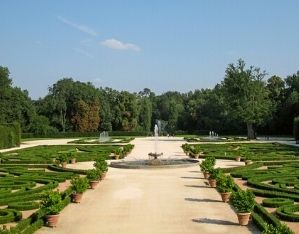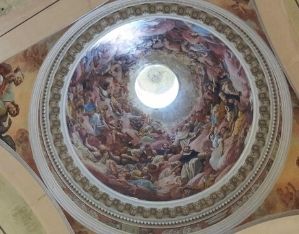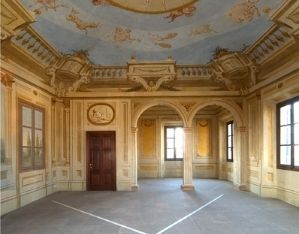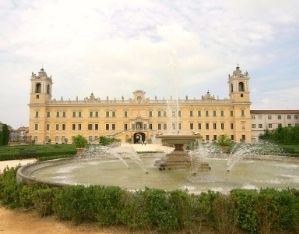Today the splendid complex of Colorno, that after the Unification of Italy was converted into an asylum and later abandoned, has reacquired its majestic identity thanks to a thorough restoration and the recreation of its mid-18th century parterre.
A first substantial transformation of the 15th-16th-century residence of the Sanseverino family was carried out between the 17th and the 18th century by Duke Francesco Farnese: under the direction of Bolognese architect and scenographer Ferdinando Galli Bibiena, the Duke’s palazzo was turned into a sumptuous suburban residence; in 1697 the garden started to take shape with its statues, parterres, fountains (including the Proserpina and Trianon fountains by Giuliano Mozzani today in Parma’s Parco Ducale), water features, and automata (with Jean Baillou’s hydraulic technology). The splendid engravings of the Delizia farnesiana a Colorno (1726) are a testimony to this phase. With the extinction of the Farnese family in 1731 and the subsequent rule of the Borbone in the Duchy, the garden underwent a radical “French style” transformation, which had already started during the Farnese period thanks to the contribution of Ennemond-Alexandre Petitot and Versailles-gardener François Anquetil “De Lisle”. Under the French rule, in 1807 Reggia di Colorno was declared “imperial palace” and, after the Restauration, the Austrian Duchess of Parma Marie Louise chose it as her favourite residence, initiating in 1816 a transformation of the garden into a park infused with Romantic aesthetics. At her side in this project was Karl Barvitius, President of the Botanical Society of London who can be credited for the introduction of rare plant species such as the Zelkova carpinifolia, currently still growing in the park. It was during this phase that the small lake with the Isola dell’amore (Island of Love) was created, and the violet and exotic fruit greenhouses installed. After years of neglect, following the Unification of Italy and World War II, Reggia di Colorno became property of the Province of Parma: between 1998 and 2000 the parterre was reinstated based on Anquetil’s project. Delimited on both sides by hornbeam galleries, its arches frame beautiful views of the parterre and the Reggia.
Highlights

The "parterre"
In keeping with Anquetil’s project, the first section of the “parterre” is divided in four symmetrical quadrants delimited by low boxwood hedges and large citrus tree vases and a circular fountain at the centre; further on there are two other areas, also surrounded by hedges, each with large fountains.

The Chapel of San Liborio
Designed by Pietro Cugini, the chapel was built between 1775 and 1777. Of note are the “tribuna ducale”, a gallery with seating for the Duke, with a narrow passageway leading to his “Appartamento nuovo” private rooms, and an organ crafted by Giuseppe Serassi between 1792 and 1796. With its set of 2898 pipes it is still working today.

The Astronomical Observatory
The “Appartamento nuovo” area, Duke Ferdinando di Borbone’s private rooms, contains a remarkable Astronomical Observatory with an unusual anemometer consisting of an external revolving part connected with a pole to a compass rose set indoors at the centre of the vault, with an arrow indicating the direction of the wind.

The Palazzo
Extended during the mid-18th century, it contains magnificently decorated rooms including the Gran Sala designed in 1753 by Ennemond-Alexandre Petitot.
 Palace of Colorno
Contacts
Palace of Colorno
Contacts
Contacts
Telephone:+39 0521 312545
Other contacts::Fax: +39 0521 521370
Address
Piazza Giuseppe Garibaldi, 26
43052, Parma (PR)
 Palace of Colorno
Opening times and prices
Palace of Colorno
Opening times and prices
Opening hours
The palace is open:
- Monday to Friday from 10 a.m. to 4 p.m. (reservation required)
- Saturdays at the following times: 10 am, 11.30 am, 3 pm and 4.30 pm
- Sundays at the following times: 10 a.m., 11.30 a.m., 2.30 p.m., 3.30 p.m., 4.30 p.m. and 5.30 p.m.
Pricing
The price of admission includes the guide.
- Full Ticket: € 7,00
- Reduced price ticket (children from 7 to 18 years old, university students with card, over 65, Passport holders of the Castles of the Duchy of Parma, Piacenza and Pontremoli, FAI members, Touring Club members with 1 companion, IREN Club, INCHotels convention): € 6,00
- Reduced price ticket for groups (groups of at least 15 people with reservation, school groups on educational visits): € 5,00
- Children up to 6 years of age, disabled persons with an accompanying person, 1 accompanying person for each organised group, 2 teachers for every 15 pupils on an educational visit, journalists with a valid identity card: Free ticket
Family ticket
- € 15,00 2 adults + 1 child up to 14 years of age
- € 20,00 2 adults + 2 children up to 14 years of age
- € 25,00 2 adults + 3 children up to 14 years of age
 Palace of Colorno
How to get there
Palace of Colorno
How to get there
Address
Piazza Giuseppe Garibaldi, 26
43052, Parma (PR)
Latitude: 44.9301627
Longitude: 10.3765911
How to arrive by road
From Milan and Bologna:
- From the A1 motorway take the Parma exit and continue on the SS 343 towards Colorno.
From Genoa – La Spezia:
- From the A15 – A1 motorway towards Bologna, take the Parma exit and continue on the SS 343 towards Colorno.
From Cremona:
- Take SS 343 direction Casalmaggiore – Colorno
From Mantua:
- Take SS 420 direction Sabbioneta – Casalmaggiore – Colorno
How to arrive by train
By train take the Parma – Brescia line
How to arrive by bus
Departure every hour from Parma Railway Station (for further information please consult the website.)
 Palace of Colorno
Services/Accessibility
Palace of Colorno
Services/Accessibility
Services
At the Reggia di Colorno it is possible to find proposals for educational workshops with different objectives and content depending on the school age of the participants. For further information please consult the website.
In the Reggia there is the Bookshop.
Small animals are allowed in the Reggia di Colorno if held in the arms and on a leash or in a suitable pet carrier. The ticket office does not provide dog sitting services.
- Groups can drop off and pick up visitors in Piazza Garibaldi, the square in front of the Reggia, after which drivers are invited to park their coaches in the car park in P.le Mazzoli (opposite the Carabinieri barracks), located about 800 metres south of the Reggia, on the Asolana state road in the direction of Parma.
- On Tuesday and Friday mornings, the days of the weekly market, visitors can get on and off the bus in Piazzale Vittorio Veneto, where there is a bus stop.
- use of flash
- photo and video services for commercial purposes without permission
- introduce food and drink, smoke in the museum spaces and offices
- bring backpacks and bulky bags during the visit (for school groups)
- bring umbrellas (to be deposited in the umbrella stands)
- leaning over, getting too close to works of art or touching furniture, upholstery, etc.
- use mobile phones, talk loudly, run or disturb in any way during the visit
Accessibility
- In the Reggia there are lifts and services for the disabled.
- The Apartment of Duke Ferdinand of Bourbon is not accessible to the disabled if in a wheelchair.
 Palace of Colorno
Private events
Palace of Colorno
Private events
At the Reggia di Colorno you can organize your wedding. For further information please consult the website.
 Palace of Colorno
Itineraries
Palace of Colorno
Itineraries
You could find the garden in these itineraries
 Favorite saving result
Favorite saving result
 Warning!
Warning!
You've have to sign up or sign in to add this element to your favorites.
